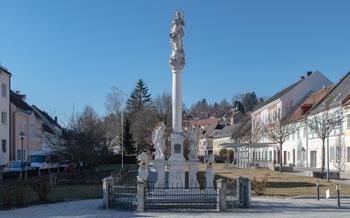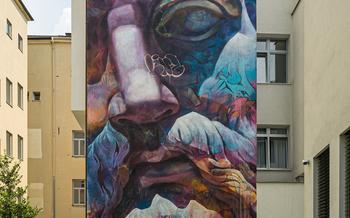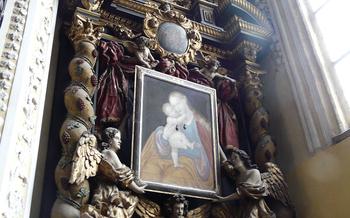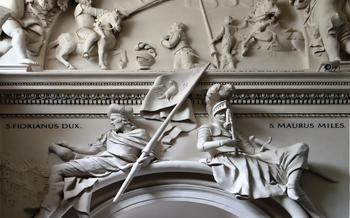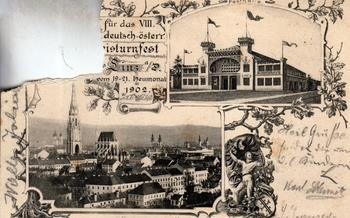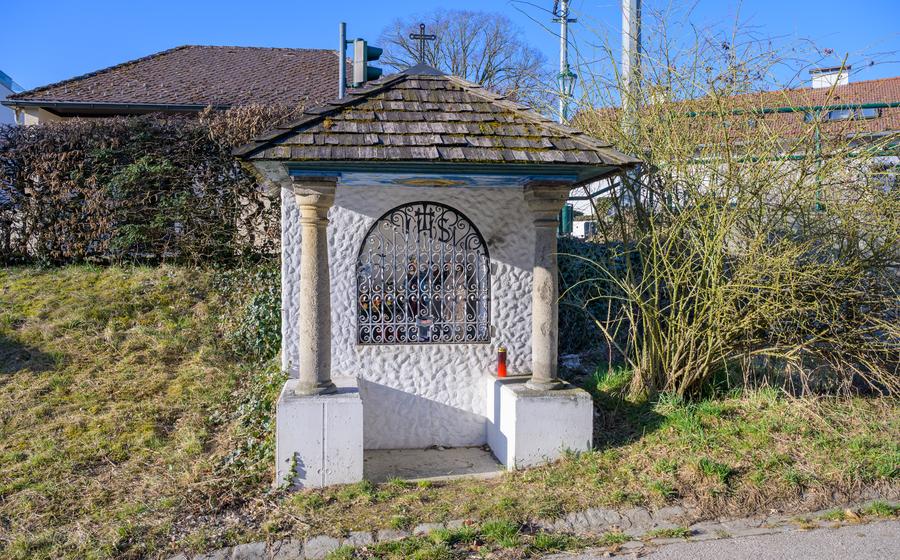
St. Florian Monastery Library (near Linz)
- St. Florian Monastery Library (Near Linz): A Haven of Knowledge and Beauty
- A Journey Through Time: The History of St. Florian Monastery
- Splendor and Grandeur: The Baroque Masterpiece
- In the Footsteps of Scholars: The Library's Collections
- A Silent Symphony: The Ambience of the Library
- Echoes of the Past: The Monastery's Cultural Legacy
- A Glimpse into Monastic Life: The Daily Routine
- The Library's Role in the Community
- Planning a Visit: Practical Information
- Guided Tours: Unveiling the Monastery's Secrets
- Capturing the Essence: Photography and Videography
- Souvenirs and Mementos: Preserving the Memories
- Insider Tip: Unveiling Hidden Treasures and Untold Stories
St. Florian Monastery Library (Near Linz): A Haven of Knowledge and Beauty
In a serene and picturesque setting just outside the vibrant city of Linz, Austria, lies a treasure trove of knowledge and beauty: the St. Florian Monastery Library. Founded in the 11th century as part of the Augustinian monastery, the library has witnessed centuries of learning, scholarship, and artistic endeavor. Its magnificent Baroque architecture, exquisite ceiling frescoes, and extensive collection of medieval manuscripts and printed books make it a must-visit destination for anyone seeking a glimpse into Austria's rich cultural heritage.
Initially established to support the spiritual and educational needs of the Augustinian monks, the library gradually evolved into a repository of knowledge that attracted scholars and bibliophiles from far and wide. Its collection grew steadily over the centuries, encompassing a vast array of subjects, including theology, philosophy, natural sciences, history, and literature. Today, the St. Florian Monastery Library stands as a testament to the enduring power of knowledge and the pursuit of intellectual enlightenment.
A Journey Through Time: The History of St. Florian Monastery
In the heart of Upper Austria, nestled amidst rolling hills and picturesque landscapes, lies St. Florian Monastery, a testament to centuries of faith, scholarship, and artistic endeavor. Founded in the 11th century by Augustinian canons, the monastery has played a pivotal role in the religious and cultural life of the region, emerging as a center of learning, spirituality, and artistic patronage.
Over the centuries, St. Florian Monastery has undergone numerous transformations, reflecting the changing architectural styles and evolving needs of its inhabitants. The Romanesque basilica, constructed in the 12th century, bears witness to the monastery's early origins. In the 17th century, a period of extensive Baroque renovation, the monastery church was rebuilt in the grand style, adorned with elaborate frescoes, intricate carvings, and a majestic High Altar. These architectural embellishments transformed St. Florian into a Baroque masterpiece, showcasing the artistic prowess and spiritual fervor of the era.
Throughout its history, St. Florian Monastery has served as a haven for scholars, theologians, and artists, fostering a vibrant intellectual and cultural atmosphere. The monastery's renowned library, housing a treasure trove of medieval manuscripts and printed books, has attracted scholars from across Europe, eager to delve into its rich collection. Notable figures associated with the monastery include the composer Anton Bruckner, who served as organist, and the theologian and philosopher Thomas Aquinas, who is said to have visited the monastery during his travels.
Today, St. Florian Monastery stands as a living testament to its rich past, inviting visitors to embark on a journey through time. Its architectural grandeur, coupled with its exceptional library collection and vibrant cultural heritage, make it a must-see destination for anyone seeking to explore the depths of Austrian history, art, and spirituality.
Splendor and Grandeur: The Baroque Masterpiece
In the 17th century, the St. Florian Monastery underwent a remarkable transformation, as the Baroque style left an indelible mark on its architecture. The construction of the monastery church, a Baroque masterpiece, stands as a testament to the artistic and spiritual fervor of the era. The church's imposing facade, adorned with intricate carvings and sculptures, invites visitors into a realm of grandeur and devotion.
The interior of the church is a symphony of Baroque elements, where every detail contributes to the overall sense of awe and inspiration. The High Altar, a focal point of the church, is a breathtaking spectacle of marble, gilding, and intricate carvings, embodying the exuberance of the Baroque style. The ceiling frescoes, painted by renowned artists of the time, depict scenes from the life of St. Florian and other religious figures, adding to the church's spiritual ambiance.
St. Florian Monastery church is not merely an architectural marvel but also a showcase of Baroque art. Its grandeur and opulence reflect the monastery's status as a center of religious and cultural influence during the Baroque period. This architectural masterpiece continues to inspire and captivate visitors, leaving an unforgettable impression of the artistic and spiritual legacy of the Baroque era.
In the Footsteps of Scholars: The Library's Collections
The St. Florian Monastery Library boasts an extensive collection of medieval manuscripts and printed books, a testament to its rich history and scholarly significance. Among its treasures are rare and valuable editions, including incunabula, or books printed before 1501, and illuminated manuscripts adorned with intricate artwork. These volumes span a wide range of subjects, from theology and philosophy to natural sciences, reflecting the diverse interests of the monastery's scholars.
The library's medieval manuscripts offer a glimpse into the intellectual pursuits of the monks and the broader cultural context of the Middle Ages. These handwritten documents cover a variety of topics, including history, law, medicine, and music, providing insights into the intellectual and spiritual life of the monastery. Among the highlights of the collection is the Codex Aureus, a 9th-century gospel book renowned for its exquisite gold leaf illuminations.
In addition to its medieval holdings, the library houses a substantial collection of printed books, many of which date back to the early days of printing. These volumes represent the dissemination of knowledge and ideas during the Renaissance and beyond. Among the notable printed works are first editions of influential scientific treatises, philosophical texts, and literary classics.
The St. Florian Monastery Library's collections are not mere relics of the past; they continue to be actively studied and consulted by scholars from around the world. The library's resources support research in a variety of fields, contributing to our understanding of history, culture, and the human experience.
A Silent Symphony: The Ambience of the Library
Stepping into the St. Florian Monastery Library is like stepping into a silent symphony, where the rustling of pages and the soft footsteps of scholars create a harmonious rhythm of knowledge and contemplation. The library's serene atmosphere invites visitors to immerse themselves in the wisdom of the ages, surrounded by the grandeur of Baroque architecture and the hushed whispers of history.
Historical library equipment, such as lecterns, tables, and writing tools, adds to the ambiance, evoking the scholarly pursuits of generations past. The gentle glow of natural light filtering through the windows casts a warm and inviting light on the rows of books, creating a sanctuary of learning and inspiration.
In this tranquil environment, visitors can experience the profound sense of peace and tranquility that has permeated the library's walls for centuries. It is a place where the mind can wander freely, where ideas can blossom, and where the pursuit of knowledge becomes a sacred act.
The silence of the library is not a stifling silence, but rather a vibrant silence, filled with the unspoken conversations of the books and the echoes of the scholars who have come before. It is a silence that invites contemplation, reflection, and a deep appreciation for the enduring power of the written word.
Echoes of the Past: The Monastery's Cultural Legacy
St. Florian Monastery has a rich cultural heritage that extends far beyond its impressive library. Throughout its long history, the monastery has been a hub of learning, teaching, and cultural exchange. Notable figures from various fields have graced its halls, leaving an indelible mark on the monastery's legacy.
One of the most famous figures associated with the monastery is Anton Bruckner, the renowned Austrian composer. Bruckner served as the monastery's organist for over a decade, and his compositions were heavily influenced by the acoustics of the monastery church. His legacy continues to live on through the annual Bruckner Festival, which attracts music lovers from around the world.
Other notable figures associated with the monastery include theologians, philosophers, and artists. The monastery's scriptorium was once a renowned center of manuscript production, and many of the manuscripts produced there are now housed in the library's collection.
The monastery's cultural legacy is not confined to the past. Today, the monastery continues to host a variety of cultural events, including concerts, exhibitions, and lectures. These events provide a platform for contemporary artists and scholars to share their work and engage with the local community.
By delving into the monastery's cultural legacy, visitors can gain a deeper appreciation for the role that this institution has played in shaping the intellectual and artistic landscape of Austria.
A Glimpse into Monastic Life: The Daily Routine
Step into the cloisters of St. Florian Monastery and experience the rhythms of monastic life. The Augustinian monks who call this place home follow a structured routine that has remained largely unchanged for centuries. Their days are dedicated to prayer, work, and study, guided by the principles of their faith.
At the heart of their daily routine lies prayer. The monks gather in the monastery church several times a day to offer their devotions to God. These services, filled with Gregorian chants and readings from scripture, create a profound sense of spirituality and connection to the divine.
In addition to prayer, the monks engage in various forms of work. Some tend to the monastery's gardens, cultivating fresh produce that sustains the community. Others work in the monastery's workshops, crafting beautiful objects that contribute to the monastery's upkeep.
Intellectual pursuits also play a vital role in the monks' lives. They spend hours in the library, poring over ancient manuscripts and engaging in scholarly discussions. The monastery's extensive collection of books and manuscripts provides a rich source of knowledge and inspiration for their studies.
Through their daily routine, the monks of St. Florian Monastery strive to live a life of simplicity, devotion, and intellectual exploration. Their dedication to their faith and community creates a unique atmosphere of tranquility and spirituality that permeates the monastery's walls.
The Library's Role in the Community
The St. Florian Monastery Library is not merely a repository of ancient texts but also an active participant in the cultural and educational life of the community. Recognizing the importance of sharing knowledge and preserving cultural heritage, the library has undertaken several initiatives to engage with the public.
Educational programs and workshops are regularly organized to introduce visitors to the fascinating world of medieval manuscripts and printed books. These programs provide insights into the history of bookbinding, calligraphy, and the art of illumination, allowing participants to delve deeper into the library's treasures.
Exhibitions and lectures are held throughout the year, showcasing rare and valuable items from the collection. These events provide a platform for scholars, historians, and enthusiasts to present their research and share their knowledge with a broader audience.
The library collaborates with local schools and universities to promote literacy and research. Guided tours specifically designed for students offer an interactive and engaging experience, allowing them to explore the library's collections and learn about the significance of preserving cultural heritage.
Through these initiatives, the St. Florian Monastery Library plays a vital role in fostering a love of learning, preserving the region's cultural identity, and ensuring that the legacy of the Augustinian monks continues to inspire and enrich future generations.
Planning a Visit: Practical Information
Before embarking on your journey to the St. Florian Monastery Library, it's essential to plan your visit to ensure a smooth and enjoyable experience. Here's a guide to help you make the most of your trip:
Location: The St. Florian Monastery is situated in the town of St. Florian, approximately 15 kilometers southeast of Linz, Austria. The monastery's address is Stiftstraße 1, 4490 St. Florian, Austria.
Visiting Hours: The library and monastery are open to the public during specific hours. The library's opening hours are typically from Tuesday to Sunday, from 10 am to 5 pm. The monastery church and other areas may have different visiting hours, so it's advisable to check the monastery's official website for the most up-to-date information.
Admission Fees: There is a modest admission fee to enter the monastery and library. The fees vary depending on the type of visit and any additional services or guided tours. Reduced rates may be available for students, seniors, and groups. It's recommended to carry cash or check the monastery's website for information on accepted payment methods.
Guided Tours: Unveiling the Monastery's Secrets
To delve deeper into the history, architecture, and collections of St. Florian Monastery, guided tours are an invaluable resource. These tours provide an immersive experience, allowing visitors to unlock the secrets of this remarkable institution.
Guided tours are available at scheduled times throughout the day, and reservations are recommended to secure a spot. Knowledgeable and passionate guides lead the tours, sharing their expertise on the monastery's founding, architectural transformations, and cultural significance.
The tours encompass the highlights of the monastery, including the awe-inspiring Baroque church, the serene library, and the enchanting monastery grounds. Visitors will learn about the Augustinian monks who have called this place home for centuries, their daily routines, and their contributions to the region's religious and cultural life.
Thematic tours are also offered, catering to specific interests. Visitors can explore the monastery's rich musical heritage, its role as a center of learning, or its connections to notable figures throughout history. These specialized tours provide an even deeper understanding of the monastery's multifaceted legacy.
Whether you prefer a general overview or a focused exploration, guided tours offer an unparalleled opportunity to uncover the hidden treasures of St. Florian Monastery. Let the expert guides transport you back in time as they reveal the stories and secrets that make this historic site so captivating.
Capturing the Essence: Photography and Videography
The St. Florian Monastery Library and monastery grounds offer a wealth of visual opportunities for photographers and videographers. Whether you are an enthusiast or a professional, capturing the essence of this cultural treasure requires both technical skill and an appreciation for its historical significance.
Photography and Videography Policies
Respectful Approach: Remember that the monastery is a sacred space and a place of learning. Always be respectful of the monks, visitors, and the library's collections. Non-Flash Photography: Flash photography is not permitted in the library to prevent damage to the delicate manuscripts and books. Tripods and Equipment: Tripods and other photography equipment are allowed but must be used responsibly, avoiding obstruction of walkways or disturbance to other visitors. Commercial Use: If you intend to use your photographs or videos for commercial purposes, you may need to obtain permission from the monastery authorities.
Guidelines for Respectful Documentation
Capture the Details: Pay attention to the intricate details of the library's architecture, frescoes, bookcases, and manuscripts. Close-up shots can reveal hidden treasures. Composition and Lighting: Consider the composition and lighting to create visually appealing images. Experiment with different angles and perspectives to capture the essence of the space. Storytelling: Think of your photographs or videos as a way to tell the story of the monastery and its library. Capture the atmosphere, the people, and the unique details that make this place special.
Tips for Capturing the Beauty and Significance
Wide-Angle Shots: Use a wide-angle lens to capture the grandeur of the library's interior and the monastery's architecture. Natural Light: Take advantage of the natural light filtering through the windows to create soft and dramatic effects. Details and Close-Ups: Don't forget to capture the intricate details of the frescoes, bookcases, and manuscripts. Close-ups can reveal the artistry and craftsmanship that went into their creation.
Through photography and videography, you can share the beauty and significance of the St. Florian Monastery Library with the world while preserving its legacy for generations to come.
Souvenirs and Mementos: Preserving the Memories
As you depart from the St. Florian Monastery, you can take a piece of its rich history and beauty with you. The monastery's gift shop, located within the complex, offers a carefully curated selection of souvenirs and mementos that will serve as lasting reminders of your visit.
Among the treasures you'll find in the gift shop are books on the monastery's history, architecture, and collections. These publications provide an in-depth exploration of the monastery's significance, allowing you to delve deeper into its fascinating story.
For a tangible reminder of the monastery's artistic splendor, consider purchasing a postcard or print featuring the breathtaking ceiling frescoes, intricate carvings, or serene courtyards. These visually stunning pieces will bring the monastery's beauty into your home, evoking memories of your visit every time you gaze upon them.
If you wish to possess a small piece of the monastery's history, replicas of medieval manuscripts or rare books are available. These meticulously crafted replicas offer a glimpse into the monastery's rich collection, allowing you to hold a piece of the past in your hands.
By purchasing souvenirs from the monastery's gift shop, you not only acquire a memento of your visit but also contribute to the preservation of this cultural treasure. The revenue generated from souvenir sales helps support the monastery's ongoing conservation and restoration efforts, ensuring that its legacy continues to inspire and captivate generations to come.
Insider Tip: Unveiling Hidden Treasures and Untold Stories
Venture beyond the main attractions of St. Florian Monastery and discover hidden gems that will enrich your visit. Seek out the secret passageways and secluded corners of the library, where forgotten volumes and intriguing artifacts may lie in wait. Engage with the knowledgeable staff or join guided tours that delve deeper into the monastery's history, uncovering lesser-known stories and anecdotes that bring the past to life.
Take a stroll through the tranquil gardens, where you might stumble upon a secluded fountain or a sculpture nestled amidst the greenery. Listen closely to the echoes of Gregorian chants that still linger within the monastery walls, transporting you back to a time when monks filled the halls with their devotions. Embrace the opportunity to experience the monastery's unique atmosphere, a blend of spirituality, history, and culture that will leave an enduring impression.
